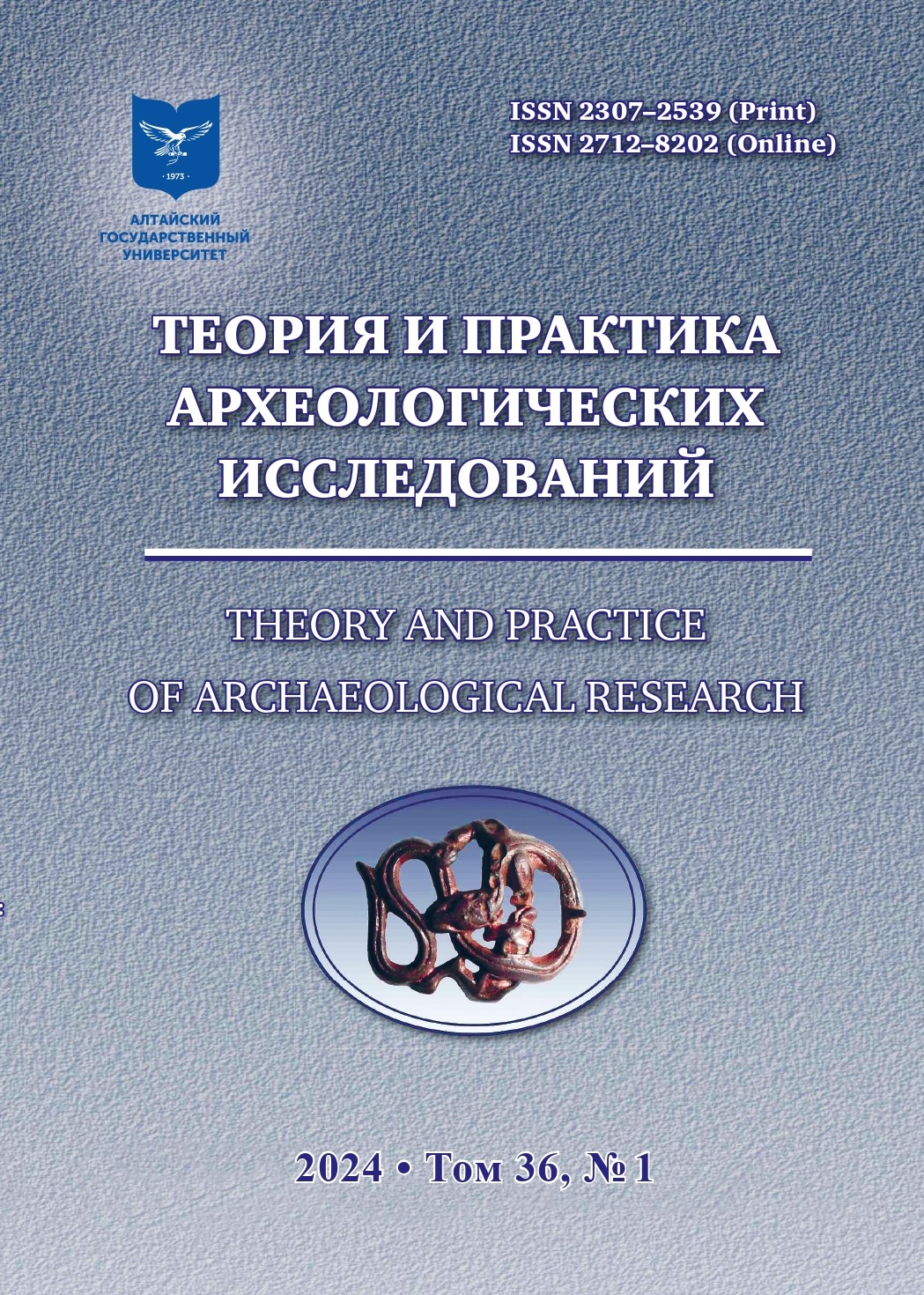PALEOLITHIC COMPLEX OF THE HOABINHIAN XOM TRAI CAVE (VIETNAM)
Abstract
In the first half of the 20th century, the French researcher M. Colani, based on archaeological work in the caves of North Vietnam, identified the Hoa Binh culture. Later it turned out that Hoabinhian industries are widespread in the Indochina Peninsula, Sumatra, and southern China. This publication is dedicated to the collection of stone tools obtained as a result of excavations by a joint Russian-Vietnamese expedition of the Xom Trai cave in 2022, discovered by Vietnamese researchers in 1980. The conducted technical and typological analysis showed that the stone industry of the Xom Trai Cave is pebble-flake and belongs to the late stage of the Hoabinhian, which corresponds to the Pleistocene-Holocene boundary. A large number of tool forms, a minimal amount of primary fission products, and evidence of intensive economic activity allow us to define this type of site as a site-settlement. The features of the Hoabinhian stone industry correspond to the type of adaptation of the ancient population, characteristic of tropical rainforests.
Downloads
Metrics
References
Kandyba A.V., Nguen Gia Doi, Karpova S.O., Chekha A.M., Derevyanko A.P., Gladyshev S.A., Le Hai Dang. Stone industry of Xom Trai Cave (excavations 1980–1981). Vestnik Novosibirskogo gosudarstvennogo universiteta. Seriya: Istoriya, filologiya = Bulletin NSU. Series: History and Philology. 2021;20(7):62–72. (In Russ.). http://dx.doi.org/10.25205/1818-7919-2019-18-5-64-68.
Chen X., He A., Sun X., Wei Q., Liu K., He C., Liang T., Yang R., Wang T., Shen Z., Forestier H. Guomo open-air site (15–12 ka) in Guangxi Zhuang Autonomous Region, Southern China: A new Cobble-Based Industry for Rethinking the Definition of ‘‘Hoabinhian’’. Journal of Archaeological Science: Reports 49. 2023; http://dx.doi.org/10.1016/j.jasrep.2023.104033, article104033.
Chitkament T., Gaillard C., Shoocongdej R. Tham Lod rockshelter (Pang Mapha district, north-western Thailand): Evolution of the Lithic Assemblages during the Late Pleistocene. Quaternary International. 2016;416:151–161. http://dx.doi.org/10.1016/j.quaint.2015.10.058.
Colani M. Deґcouverte d’industries paleґolithiques dans la province de Hoa-Binh, Tonkin. L’anthropologie. 1926;36(5–6):609–611.
Colani M. L’age de la pierre dans la province de Hoa Binh (Tonkin). Meґmoires du Service Geґologique de l’Indochine. 1927;XIV(1):86.
Colani M. Quelques Paleґ olithes hoabiniens typiques de l’Abri sous roche de Lang-Kay. Bulletin de la Socieґteґ Prehistorique Francaise. 1929;26(6):353–384.
Conrad C., Shoocongdej R., Marwick B., White J.C., Thongcharoenchaikit C., Higham C., Feathers J.K., Tumpeesuwan S., Castillo C.C., Fuller D.Q., Jones E.L. Re-Evaluating Pleistocene–Holocene Occupation of Cave Sites in North-West Thailand: New Radiocarbon and Luminescence Dating. Antiquity. 2022;96(386):280–297. http://dx.doi.org/10.15184/aqy.2021.44.
Hoang Xuan Chinh. Hoa Binh Culture in Vietnam. Hanoi, 1989. 260 p.
Forestier H. La pierre et son ombre: Epistemologie de la prehistoire. Paris : Editions l’Harmattan, 2020. 274 p.
Forestier H., Sophady H., Celiberti V. Le techno-complexe hoabinhien en Asie du Sud-est continentale: L’histoire d’un galet qui cache la foret. Journal of Lithic Studies. 2017;4(2):305–349. http://dx.doi.org/10.2218/jls.v4i2.2545.
Forestier H., Zhou Y., Viallet C., Auetrakulvit P., Li Y., Sophady H. Reduction Sequences during the Hoabinhian Technocomplex in Cambodia and Thailand: A New Knapping Strategy in Southeast Asia from the Terminal Upper Pleistocene to Mid Holocene. Lithic Technology. 2022;47(2):147–170. http://dx.doi.org/10.1080/01977261.2021.1981654.
Forestier H., Griggo C., Sophady H. L’Hoabinhien ou le paradigme egare de la modernite europeenne en Extreme-Orient: l’exemple de la Prehistoire du Cambodge. In: Bulletin de la Societe´ Prehistorique Francaise. 2023. Pp. 59–76. URL: https://hal.science/hal-04017023/file/05_Forestier%20et%20al.pdf (accessed January 28, 2024).
Gorman C.-F. Excavations at Spirit Cave, North Thailand: Some Interim Interpretations. Asian Perspectives. 1970;13:79–107.
Ha V.-T. The Hoabinhian in Southeast Asia: Culture, Cultures or Technocomplex. Vietnam Social Sciences. 1994;5(43):3–8.
Kandyba A.V., Nguyen K.S., Gladyshev S.A., Nguyen G.D., Chekha A.M., Derevianko A.P. Con Moong Cave — a Stratified Late Pleistocene and Early Holocene Site in Northern Vietnam. Archaeology, Ethnography and Anthropology of Eurasia. 2020;48(4):45–56. http://dx.doi.org/10.17746/1563-0110.2020.48.4.045-056.
Kandyba A.V., Nguyen K.S., Checha A.M., Nguyen G.D., Le H.D., Nguyen A.T., Derevianko A.P. Ɖiem Cave: A Stratified Late Pleistocene and Early Holocene Site in Northern Vietnam. Archaeology, Ethnology and Anthropology of Eurasia. 2023;51(3):130–139. http://dx.doi.org/10.17746/1563-0110.2023.51.3.130-139.
Li Y., Lam T.M.D., Dang H.S., Li F., Forestier H., Zhou Y. Chen P., Wang L., He C., Liang T. A New Technological Analysis of Hoabinhian Stone Artifacts from Vietnam and Its Implications for Cultural Homogeneity and Variability between Mainland Southeast Asia and South China. Asian Perspectives. 2020;60(1):71–96. http://dx.doi.org/10.1353/asi.2020.0037.
Marwick B. The Hoabinhian of Southeast Asia and Its Relationship to Regional Pleistocene Lithic Technologies. In: Lithic Technological Organization and Paleoenvironmental Change: Global and Diachronic Perspectives. Issue 9. Studies in Human Ecology and Adaptation. Cham : Springer International Publishing AG, 2018. Pp. 63–78. http://dx.doi.org/10.1007/978-3-319-64407-3_4.
Masojc M., Le H.D., Gralak T., Michalec G., Apolinarska K., Badura Cendrowska M., Galas A., Krupa-Kurzynowska J., Miazga B., Osypinska M., Rozok Z., Viet N. The Early Holocene Hoabinhian (8300–8000 cal BC) Occupation from Hiem Cave, Vietnam. Comptes Rendus Palevol. 2023;22(5):59–76. http://dx.doi.org/10.5852/cr-palevol2023v22a5.
Moser J. Hoabinhian: Geographie und Chronologie eines steinzeitlichen Technokomplexes in Sudostasien, 6. Verlag Linden Soft, AVA Forschungen, Koln, Germany. Koln : Lindensoft, 2001. 194 p.
Moser J. The Hoabinhian Definition. In the Past and Today: A Short Historical Review of Defining the Hoabinhian. In: Crossing Borders: Selected Papers from the 13th International Conference of the European Association of Southeast Asian Archaeologists. Singapore : NUS Press, 2012. Issue 1. Pp. 3–25.
Nguyen K.-S. Hoa Binh Culture in Vietnam after Nearly a Century Since Its Discovery. Vietnam Social Science. 2021;202(2):26–43.
Nguyen K.-S. Hoabinhian in Vietnam and Economic Activities from 20000 to 7000 Years BP. Dalat University Journal of Science. 2023;13(4):64–81.
Nguyen Van Binh. Excavation at Xom Trai Cave (Ha Son Binh province) — a Short Report. In: New Archaeological Discoveries in Vietnam 1981. Hanoi, 1981. Pp. 38–39.
Nguyen V.-B. Back to the Periodization of Hoabinhian in Vietnam. In: Recentes Recherches en Archeologie en Thaılande, The Twelfth Franco-Thai Symposium. Bangkok : Silpakorn University, 1991. Pp. 166–171.
Nguyen Viet. Excavations at Hoabinhian Xom Trai Cave (North-Vietnam). In: 2nd International Conference of Association of SEA-Archaeologists in Western Europe, 9/1988. Paris : Editions Hoëbeke, 1988. Pp. 76–79.
Nguyen Viet. Homeland of the Hoabinhian in Vietnam. In: Unpublished Communication Presented at the European Southeast Asian Archaeologists Association, Sarteano — Italia, 2–6 October 2000. URL: http://www.drnguyenviet.com/?id=5&cat=1&cid=33 (accessed January 28, 2024).
Nguyen Viet. Hoabinhian Food Strategy in Vietnam. In: South-East Asian Archaeology: Wilhem G. Solheim II Festschrift. Manila : University of Philippines Press, 2004. Pp. 442–462.
Nguyen Viet. Hoabinhian Macrobotanical Remains in Vietnam as an Indicator of Climate Changes from Late Pleistocene to Early Holocene. In: Bulletin of Indo-Pacific Prehistory Association:
Proceedings of the 18th Congress of the Indo-Pacific Prehistory Association. Manila : Philippines, 20 to 26 March 2006. Vol. 28. Pp. 80–83. URL: https://journals.lib.washington.edu/index.php/BIPPA/issue/view/770 (accessed January 28, 2024).
Nguyen Viet. ArchaeoEthnobotany Records of Canarium in Vietnam and in SEA. In: Archaeological and Ethnobotanical Records of Canarium in Vietnam and Southeast Asia. 2008. URL: http://www.drnguyenviet.com/?id=5&cat=1&cid=36 (accessed January 28, 2024).
Nguyen Viet, Ha Huu Nga, Nguyen Kim Dung. Re-excavation at Xom Trai cave (Ha Son Binh provinze). In: New Archaeological Discoveries in Vietnam 1982. Hanoi, 1982. Pp. 43–47.
Rabett R., Ludgate N., Stimpson C., Hill E., Hunt C., Ceron J., Farr L., Morley M., Reynolds T., Zukswert H., Simpson D., Nyiri B., Verhoeven M., Appleby J., Meneely J., Phan L., Dong N.N., Lloyd-Smith L., Hawkes J., Blyth A., Tan N.C. Tropical Limestone Forest Resilience and Late Pleistocene Foraging during MIS-2 in the Trang An Massif, Vietnam. Quaternary International. 2017;448:62–81. http://dx.doi.org/10.1016/j.quaint.2016.06.010.
Shoocongdej R. The Hoabinhian: The Late and Post-Pleistocene Cultural Systems of Southeast Asia. In: The Oxford Handbook of Early Southeast Asia. Oxford : Handbooks, 2022. Pp. 149–56. http://dx.doi.org/10.1093/oxfordhb/9780199355358.013.16.
White J.-C., Gorman C.-F. Patterns in “Amorphous” Industries: the Hoabinhian Viewed through a Lithic Reduction Sequence. In: Southeast Asian archaeology: Wilhelm G. Solheim II Festschrift. Quezon City : University of the Philippines Press, 2004. Pp. 411–441.
Wu Y., Qiu K., Luo Y., Yang Q., Huang Z., Wen J., Ji X., Li Y., Zhou Y. Dedan Cave: Extending the Evidence of the Hoabinhian Technocomplex in Southwest China. Journal of Archaeological Science: Reports 44. 2022; http://dx.doi.org/10.1016/j.jasrep.2022.103524, article 103524.
Yi S., Lee J.J., Kim S., Yoo Y., Kim D. New Data on the Hoabinhian: Investigations at Hang Cho cave, Northern Vietnam. In: IPPA Bulletin. Vol. 28. Pp. 73–79. URL: https://journals.lib.washington.edu/index.php/BIPPA/issue/view/770 (accessed January 28, 2024).
Zeitoun V., Forestier H., Nakbunlung S. Prehistoires au sud du Triangle d’Or. Paris : IRD Editions, 2008. 252 p.
Copyright (c) 2024 А.В. Кандыба, Ле Хай Данг, А.М Чеха, С.А. Егорова

This work is licensed under a Creative Commons Attribution 4.0 International License.
Theory and Practice of Archaeological Research is a golden publisher, as we allow self-archiving, but most importantly we are fully transparent about your rights.
Authors may present and discuss their findings ahead of publication: at biological or scientific conferences, on preprint servers, in public databases, and in blogs, wikis, tweets, and other informal communication channels.
Theory and Practice of Archaeological Research allows authors to deposit manuscripts (currently under review or those for intended submission to ABS) in non-commercial, pre-print servers such as ArXiv.
Authors who publish with this journal agree to the following terms:
- Authors retain copyright and grant the journal right of first publication with the work simultaneously licensed under a Creative Commons Attribution License (CC BY 4.0) that allows others to share the work with an acknowledgement of the work's authorship and initial publication in this journal.
- Authors are able to enter into separate, additional contractual arrangements for the non-exclusive distribution of the journal's published version of the work (e.g., post it to an institutional repository or publish it in a book), with an acknowledgement of its initial publication in this journal.
- Authors are permitted and encouraged to post their work online (e.g., in institutional repositories or on their website) prior to and during the submission process, as it can lead to productive exchanges, as well as earlier and greater citation of published work (See The Effect of Open Access).








2.jpg)



